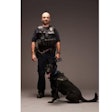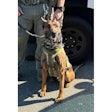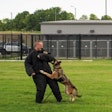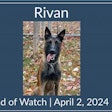Intimidation and retaliation spur the growth and violence of black Los Angeles street gangs.
When black street gangs first appeared in South Central Los Angeles in the 1920s, they were comprised of family members and close friends. To enhance a gangster image and establish income, members involved themselves in limited criminal activity. But by the mid- '50s, a new generation of African-American neighborhood groups had developed within South Central. And there was only one requirement for participation: You had to be from the same neighborhood as the other members.
As rivalries and confrontations developed, smaller neighborhoods banded together for protection, and eventually evolved into the black street gangs we know today.
By the early '60s, the gangs adopted names and became territorial. Individual gangs in separate territories, called sets, were usually divided by boundaries such as freeways or urban developments, but maintained their identification with a particular gang.
Fights took place at prearranged locations. The weapons used were baseball bats, chains and occasionally knives, but almost never firearm. Strong-arm robberies, burglaries and assaults, as well as illegal dice games and limited narcotic sales, were common. The favorite drugs for personal use were "uppers" (amphetamines), "downers" (barbiturates) and marijuana.
Bloods vs. Crips
There are many different stories about how the Blood and Crip gangs developed. One of the most popular is the "Washington High School" story. The most popular gang in Watts, Calif., by the 1970s was the "Avenue Boys." led by Craig Munsen, Stanley 'Tookey" Williams and Raymond Washington. They developed a unique style of dress (AI Capone-style hats. leather coats, Levi's or sharkskin pants) that was just as intimidating as their reputation. They also wore an earring in the left ear and walked with closed umbrellas or walking sticks.
Washington eventually separated from the Avenue Boys, moved to West Los Angeles and attended Washington High School. He developed a new following, and to distinguish themselves from other street gangs, members wore blue handkerchiefs, blue sweatshirts, Levi's, tennis shoes and baseball caps. Washington reportedly always walked with a cane.
At this time, Black students were being bussed from the inner-city areas of Los Angeles to predominantly white schools in the San Fernando Valley. Williams, Washington and a third youth, Michael Conception, began to victimize students attending neighboring Centennial High School. Within a short period of time, they gained a significant following.
But when Washington, Williams and a small group of followers attacked Silvester Scott and Benson Owens, it set off a significant chain of events. Benson and Scott, who both lived on Piru Street in nearby Compton, refused to be victimized and fought off the attack. Allegedly, at the end of the confrontation, someone said, "Don't mess with anyone from Piru Street, and take that crip nigger with you."
Scott later became the founder of "Piru Street," and Owens started the "Westside Pirus." Both were initially started for protection against Washington's gang, called the Crips. They identified themselves with trademark red clothing and developed into what we now know as the "Blood" street gangs.
The most accepted story of how the Crips got their name is that Washington's use of his cane led to the nickname "Crip," for crippled.
Robberies, assaults and extortion were common activities for Crip gangsters. Although these crimes usually took place on or near the Washington High School campus, the Crips would also travel to other neighborhoods and victimize the youth groups or gangs residing there. They quickly developed a dangerous and violent reputation.
As a result of the Crip attacks on other neighborhoods, youth groups banded together for protection and formed their own gangs. Many Crip sets were established using a street name or the name of a local park with "Crip" added at the end.
Crip gangs started to use graffiti, already common among Latino gangs, to mark their territory. The areas Crip gangs occupied became known as the "hood," and leaders began recruiting new gang members from local neighborhoods.
The larger the set, the more powerful and fearful it generally was. "Crips don't die, they multiply" became a popular saying, and Crip gangs started developing throughout Los Angeles County.
As the conflicts between Crip sets and other gangs increased, so did the level of violence. Fistfights were a thing of the past, and gang members began to arm themselves with small caliber handguns, rifles and sawed-off shotguns. When a homeboy was killed in the violence, gang members responded with more violent forms of retaliation. Crip gang violence escalated to the point where drive-by shootings became a common occurrence. By 1968, the Crips were already an established violent street gang.
Gang rivalries had existed between Los Angeles and Compton gangs for a long time. But the Pirus were outnumbered almost three to one by the Crips. To overcome this difference, the Pim gangs became increasingly violent and developed the reputation of being the more violent of the two. Other Blood gangs quickly formed and followed the Pirus.
The Pirus made Centennial High School in Compton the predominant school for the Bloods, just as the Crips did with Washington High School in Los Angeles. During the 1970s, the gang populations of both the Bloods and the Crips exploded throughout Los Angeles County.
Identifiers
The two gangs now share many of the same identifying characteristics. They both use graffiti containing the gang name with a roster of its members. The color of the graffiti is important. Crips use blue, and the Bloods use red whenever possible.
Bloods try to avoid using the letter "C" in their graffiti because of its connotation with Crips. Likewise, the Crips avoid using the letter "B" in their graffiti. When the letters must be used, they are crossed out with an "X." Both the Crip and the Blood gang members tattoo themselves with their gang names or slogans.
Tattoos can show allegiance to a set; however, they are a fairly recent trait among gang members. Tattoos have the same function as stylized clothing, graffiti and hand signs-to offer a greeting, issue a challenge or intimidate.
Hand signs are used as a form of silent communication between gang members. They can be flashed or thrown to show disrespect or to challenge rivals. Crip gang members form the letter "C" as their hand sign; Blood gang members use the letter "B." Hand signs can also be shown by forming several letters consecutively, announcing a member's gang and his specific set.
The commonly used clothing colors for the Blood gangs are still red and white. But they often use different colors to identify sets. The color green is used by the "Lime Hood Pirus." The clothing styles of black gang members have changed three or four times over the last 10 years. At one time, bib overalls were popular. Next, brand-name sports gear was common. But no matter what the fashionable style, red or blue is usually worn. Shoelaces, a baseball cap or a belt buckle can all signify gang affiliation.
Gang Slang
The word "blood" is an old African-American slang term meaning "brother." Today, Bloods call each other "blood" as a form of greeting. The initials "CK" often identify a "Crip killer" or "cop killer."
Crips avoid using the letter "B" when speaking or writing. To gang members, the letter "B" refers to Bloods. The initials "BK" refer to "Blood killer."
Both Bloods and Crips use the initials "OG" to describe an "original gangster." Normally, this term is used to describe an older gang member who has been in prison or with a particular gang for a long time. However, today you can find gang members as young as 14 using this term to describe themselves.
Other terms used by both Crips and Bloods are "cluck head," a person who smokes crack cocaine; "mission," achieve-by shooting; and "gang banging," fighting other gangs.
Insults can be exchanged through verbal challenges, graffiti and hand signs. If a Blood wants to insult a Crip, he calls him a "crab" or "e-rickette" (pronounced erick). If a Crip wants to insult a Blood he calls him a "slob." Both types of verbal insults are accepted as challenges to fight. These fights have ended in knife attacks and shootings.
Today's gangster is more likely to use a gun than his fists to resolve a problem. Bitter rivals, Bloods are always ready to fight Crips. Crip sets have been known to fight other Crips, but it is unusual for Blood sets to fight each other.
A recent trend indicates that both Blood and Crip gangs have started to war with Latino street gangs. Latino street gangs, until recently, did not present a challenge to black street gangs, and they coexisted respectfully, if not always peacefully.
Drugs in the Hood
Drug sales by the gang community began to nourish in the mid-70s. The most common drugs on the market were phencyclidine (PCP), marijuana, barbiturates and amphetamines. In late 1981, black street gangs began selling cocaine, first in its basic "rock" form and later as "crack" to double or triple their investment. Initially, most of these sales were confined to areas occupied by Crips and Bloods.
Soon drug operations spread throughout California and the surrounding Western states. Today, crack cocaine can be found anywhere. Some black gang drug operations have become so sophisticated they parallel those of the traditional Italian organized crime syndicates.
The term "rock house," describes a rented house where crack cocaine is manufactured, sold and sometimes used. The drug business has even created specific jobs. "Mules" transport the drugs; "street peddlers" sell them on the street; "lookouts" watch for the police and warn the street peddlers; and '"enforcers" use threats and violence to collect unpaid debts. "Intelligence gatherers" collect all the information they can regarding other drug dealers and law enforcement operations.
The Crips and Bloods have now moved into their second generations, and traditions are being established within these gang families. The street gang lifestyle has become an acceptable way of living for some families. Within a single set there can be as many as four subsets or subdivisions: the OG, the gangster, the BG (baby gangster), and sometimes the TG (tiny gangster). Be safe.
Al Valdez is an investigator with the Orange County (Calif.) District Attorney's Office and the author of the book. "Gangs,' He is also a consultant to the Orange County Board of Education, the California Department of Justice and the Office of Juvenile Justice and Delinquency Prevention.













